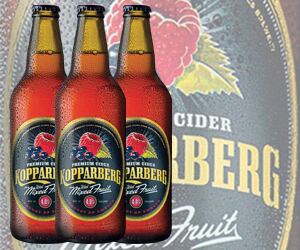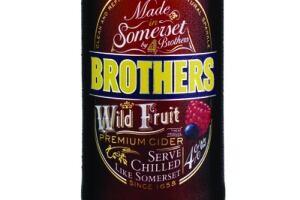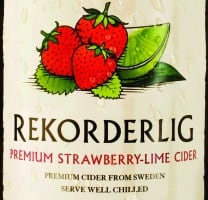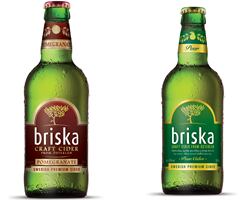Sales of ciders are still soaring and, this year, cider makers are continuing to celebrate orchards’ imperviousness to the recession. Total cider sales in terms of volume are up 0.3%, but value sales figures give a clearer picture of how buoyant the cider market really is within the on-trade, with the total value of cider up 8.1%, according to the latest CGA Strategy figures.
But, if there’s one thing to note about the cider category, it’s that it is becoming increasingly crowded — especially in the fridge. Volume sales of draught cider have slipped by 9.5%, while packaged cider is up a whopping 21.1%. And, if you want to get in on the trend, finding space in the fridge is your first goal.
So, what’s leading in cider?
In short: fruit ciders in bottles. With sales up 68.2% in value and 67% in volume, they are positively soaring in the on-trade. So, stocking a fruit cider right now really would place your pub at the heart of the trend.
Apple cider, which pioneered the category in its infancy, is no longer the main focus for cider makers or licensees as we see volume figures dropping by 7.1% and value figures remaining fairly static at 0.4%. In the meantime, pear cider, or perry as it is sometimes known, which has dipped around 3% in volume, is still enjoying a 2.7% value lift. But really, it’s fruit ciders that are publicans’ new best friend.
They’re getting experimental which means that brands such as Kopparberg’s Mixed Fruit and Strawberry & Lime variants, Bulmers No17 and Rekorderlig’s Strawberry & Lime cider are getting the most attention.
Top four fruit ciders (by value)

- Kopparberg Mixed Fruit
- Bulmers No17
- Kopparberg Strawberry & Lime
- Rekorderlig Strawberry & Lime
However, cider is still evolving. It began with apple, moved on to pear and now it seems every fruit is getting in on the action. But we can see that the apple ciders that sell well are still the original mainstream premium brands — the likes of Strongbow, Magners Original, Bulmers Original, Blackthorn and Woodpecker have maintained their place in the ranking, despite seeing their value figures drop.
Meanwhile, apple ciders such as Thatchers Gold, Stowford Press, Magners Golden Draught, Aspall Suffolk Cyder and Stella Artois Cidre have all climbed to the top of the tree and are known not just as iconic premium brands, but also aspirational and credible ones. In essence, when it comes to choosing an original cider as a core brand, a well-known name is key.
Top 10 apple ciders (by value)
- Strongbow
- Magners Original
- Bulmers Original
- Thatchers Gold
- Stowford Press
- Magners Golden Draught
- Aspall Suffolk Cyder
- Stella Artois Cidre
- Blackthorn
- Woodpecker
“To establish a reputation for cider, it is important licensees stock a range that provides consumers with a real choice,” says Chris Jowsey, trading director of Star Pubs & Bars. “As a starting point it should include popular choices — an original cider. It should also consist of new and interesting flavour variants to satisfy cider drinkers’ ongoing desire for experimentation.”
The wide range of different ciders and perry means there are plenty of products to appeal to different consumers enjoying a variety of drinking occasions — be it brands with popular appeal in destination venues for 20-something drinkers, or a premium cider to be shared and enjoyed with food.
“Cider enjoys a much more even gender split than any other category — it is enjoyed equally by men and women, as well as a broad demographic in terms of age,” says Simon Russell, spokesman for the National Association of Cider Makers.
For pear cider, Kopparberg has done a fantastic job of mingling with heavyweights Magners and Bulmers, really carving out its niche through sheer credibility and great word-of-mouth recommendations.
Top three pear ciders (by value)
- Kopparberg Pear
- Magners Pear
- Bulmers Pear
“In 2013 we will stick to investing in the marketing and promotion of the core Kopparberg range — Apple, Pear, Mixed Fruit and Strawberry & Lime,” says Kopparberg head of marketing Rob Calder.
This demonstrates that change for the sake of change isn’t a relevant move for a brand that has been ahead of the curve for some time.
So, why is there growth in the fruit-cider category?
This is largely because cider brand owners are aware that the average cider drinker is growing up and experimenting with other new styles of drink. Cue a series of new flavour variants and stylish packaging updates with nods to provenance, traceability and heritage, all of which are designed to appeal to a slightly more conscientious consumer. Added to this, growth in fruitier options has stemmed from a spike in sales among the top three mixed-fruit cider brands and some copycat behaviour from others eyeing the trend and wanting a piece of the pie.
However, predominantly, the uplift in fruity cider launches began from two persistently nagging concerns within the trade:
- The first being that the cider-drinker demographic could grow complacent and fickle, leading it to seek variety elsewhere. Therefore, the category needs to remain interesting to maintain its audience.
- And the second that the cider drinker is no longer 18 to 25, but now ranges up to 35 and above for some brands and, as drinkers mature, so do their palates. This means that, as people become more discerning and conscientious they are likely to become more interested in the heritage, provenance and ingredients they consume. And as a result, ciders really need to evolve with them.

For instance, Matthew Showering, managing director at Brothers, recently highlighted “the changing needs in the British cider market” and revealed it was a key driver behind the brand’s new packaging.
“We know more people than ever are drinking cider and we recognise that the early adopters of Brothers, who discovered our cider at Glastonbury, have grown older and wiser. “By giving our range a new look, we are offering drinkers a premium, modern British drink,” says Showering, before adding: “Wild Fruit flavour replaces Tutti Frutti as Brothers felt it was a better description of the product’s ingredients.”
What we’re seeing here is a change in vernacular that will almost certainly make it more appealing to discerning drinkers.

Another brand pandering to the more conscientious consumer is Aspall. Its Suffolk Cyder sits pretty in the top 10 list of apple cider brands selling well and has become increasingly inventive in linking itself to outdoor spaces specifically for cider drinking, as well as cider festivals within pubs. In addition, by promoting the use of its vinegars in more foodie pubs, the brand has successfully built up many positive relationships.
“We have helped our customers to create cyder gardens, of which Geronimo outlet the Fentiman Arms, in Kennington, south London, was Aspall’s first when we opened it three years ago. We work with pubs to help them create in-pub cyder festivals in the summer months; and we are continually helping pub chefs to create bespoke recipes that use not only our cyders but our vinegars too,” says Aspall partner Barry Chevallier Guild.
“We’ve also helped run competitions to see whether cider matches food better than wine, which helped bring some 60 people to a pub last month to taste the difference, with perhaps a surprising result! We find it’s this sort of thing that adds some theatre to the simple art of pouring a pint of cider, and then generates dialogue by challenging people’s perceptions about the category,” adds Chevallier Guild.
He points out that “the Aspall Premier Cru is the ideal accompaniment to spicy foods, particularly curry or Thai, as it is able to cut through the stronger, spicier flavours extremely well”, while “Aspall Organic Suffolk Cyder works extremely well with a wide range of foods, in particular cheese such as strong Cheddars, Blue Stilton and pungent, ripe French cheeses”.
Gareth Whittle, managing director of Chilli Marketing, agrees that the relationships built with pubs and bar owners is crucial and something that should be personally tailored to each individual outlet.
“Bespoke activity with accounts is something we actively look to push,” says Whittle, adding that, for Rekorderlig cider in particular, “each customer is equally important and we endeavour to provide a support package that works for them”.
Rekorderlig cider was first created in 1999 with spring water from Vimmerby, Sweden, where it is still brewed today. It launched in the UK in 2009 and, in less than four years, has seen phenomenal growth.

Rekorderlig has “more than trebled in size in the past year alone”, says Whittle, adding that “innovation is key to driving and reinforcing our brands’ premium feel, as are the brand experiences”.
And it makes sense that, in a crowded marketplace, standing out will become more important.
At Heineken, the company says that it’s all about meeting demand and providing something for the ‘everyday segment’, as well as what it calls the ‘modern cider’ segment — the exciting variants that create a lot of buzz about them.
“No less than 50% of today’s cider consumers have been drawn to the category in the past five years and the majority of these new drinkers have been primarily attracted by the exciting innovation that the category has seen,” says Darryl Hinksman, head of on-trade customer marketing at Heineken, which continues to lead the sector with innovations across both its Strongbow and Bulmers ranges.
“New taste experiences remain key across the whole category, particularly in ‘modern cider’. To meet consumer demands for new taste experiences Bulmers has introduced a successful series of permanent and limited-edition variants intended to fuel excitement, awareness and trial in modern cider,” says Hinksman, adding that “this includes the hugely successful Bulmers No17”.
Martin Thatcher, managing director and fourth-generation cider maker at Thatchers Cider, says: “As the popularity of traditional cider has spread, so we are now seeing increased demand from publicans throughout the country for some authentic cider.”
Thatcher points out that his eponymous brand has just launched Thatchers Somerset Mixed Fruit to sit alongside its pear and rosé ciders within the Somerset fruit-cider range. “There will be a marketing campaign over the spring and summer to support this launch,” he says.
At Easter, Thatchers launched a new £3m advertising campaign for Thatchers Gold, which puts the cider on TV and will help boost sales in pubs, as well as investing another £1m in further support for the brands, “making a total of £4m in 2013”.
One of the biggest success stories for the cider category has to be the rise of Stella Artois Cidre. AB InBev launched its Continental-style apple cider into the on-trade in May 2011 and a year later followed it with Stella Artois Cidre Pear.
“Stella Artois Cidre Apple is a real success story,” says Tim Clay, on-trade sales director at AB InBev UK, adding that, in the on-trade, the brand continues to grow in popularity, with volume share increasing month on month.
“Stella Artois Cidre already has 10,000 distribution points and we want to continue to grow the brand in the right outlets — those venues that offer the quality and premium serve that our consumers have come to expect and enjoy,” he adds.
All eyes are now on the brand to see how long it takes before AB InBev releases a mixed-fruit variant of Stella Cidre.
Another one to watch is Westons. By the cider maker’s own admission, it has quite a few things in the pipeline.
Helen McIlveen, customer marketing manager at Westons, recently revealed that the company will be “continually looking to innovate all of our brands here at Westons, to keep up with trends and an ever-changing market, and as such we have a number of exciting plans for 2013”.
McIlveen recommends that, rather than just having one cider on draught, licensees should consider having a second hand-pulled premium cider. “Through Westons this could be a premium mainstream brand such as Stowford Press, a super-premium cider such as Wyld Wood Organic, or traditional cloudy cider such as Old Rosie.”

However, volume sales of draught cider have fallen and are showing that draught isn’t really getting much attention, despite the fact that it sidesteps the issue of fridge space. Indeed, a bottle in hand that affords a bit of image-boosting kudos for the drinker appears to have far more traction in the pub.
Certainly, with other brands joining the already overcrowded category, there are still various niches and needs for them to fill.
The new Somersby cider, a medium-dry 4.5% ABV mainstream draught drink from Carlsberg, is made without artificial flavours or sweeteners, making its ideal demographic 30 to 45-year-old adults — drinkers that many of the other brand owners are beginning to neglect.
Somersby represents Carlsberg UK’s first entry into the cider market and, according to Kevin Paterson, marketing communications manager at Carlsberg UK: “The time was right to provide a cred-ible mainstream alternative for our pub customers and consumers.”
And Carlsberg hasn’t taken any chances. “In the launch of Somersby cider, we are embarking upon a massive £10m support programme to drive awareness, trial and demand for the brand. This includes TV advertising, PR, online, sampling, bespoke glassware, PoS and sales promotions,” says Paterson adding that, through such a high-profile marketing campaign, Carlsberg aims to “offer a strong proposition to licensees”.
Another newcomer, Briska, a premium Swedish craft cider from Proof Drinks, has also entered the market, showcasing a new 500ml bottle size to complement the existing 330ml and draught formats. But it doesn’t stop there — Briska brings with it interesting variants such as Pear and Pomegranate, as well as a decent buzz from sampling and social-media campaigns.

“The rollout of the 500ml bottle in Pear and Pomegranate variants marks the next phase of the brand’s seeding strategy in the UK,” says Proof Drinks’ sales director Luke Wade, who says Briska has been “making waves among cider drinkers”.
CGA Strategy’s Mark Campbell points out that new launches are feeding the category and that “declines are among the larger, more mainstream brands, with smaller, more premium brands showing shoots of growth. This year is set to see even more evolution of the fruit-cider market, with more weird and wonderful flavours entering the trade.”
However, many cider companies wonder how long it will be until the bubble bursts.
Without a doubt, the cider-over-ice serve gave the category the boost it needed way back in 2007. But times have changed and the sunshine drink of choice now straddles the seasons with mulled and warm spiced serves, such as Rekorderlig’s Winter Cider (apple, cinnamon and vanilla) and Westons Twist Mulled Cider, and berry, passion fruit and pomegranate variants continue to crop up to offer something new and enticing.
In the meantime, bottles and fonts will change in style and measure, of this we can be sure.
Ultimately, there is one thing to be said of cider — what we, and our customers, like about it will certainly continue to bear fruit.
Take a closer look at this years cider trends.
